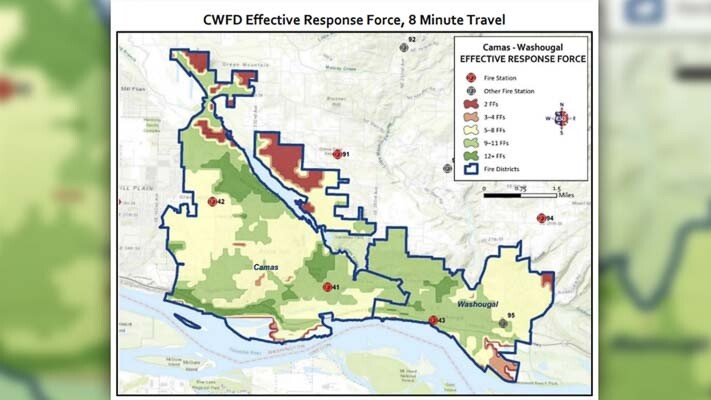
Camas Washougal Fire Department under significant financial strain due to a spate of recent hiring
John Ley
for Clark County Today
During a recent League of Women Voters Clark County candidate debate, candidates were asked how they saw the Camas Washougal Fire Department (CWFD) working for the next 10 years. Washougal Mayor Dave Stuebe told the community “our fire issue has been very frustrating.” He believes there was an answer two years ago. “We need to make a decision,” Stuebe said.
One of the biggest financial challenges for the cities of Camas and Washougal, is the CWFD. Following a spate of recent hiring, Washougal can’t afford its contractual share of the new firefighter positions. Camas picked up $25 million of the cost.
In April 2012, the two cities combined their fire departments. The current agreement is under significant financial strain. The city of Camas has day-to-day management authority and pays about 60 percent of the costs.
Back in 2019, Camas hired four new firefighters and a new supervisor. The CWFD annual report stated the following.
“The year 2019 also saw some of the most substantial personnel additions we’ve seen in nearly two decades. Four new full time positions were added to our line staff in 2019, along with a new deputy fire marshal. These positions will help with our daily staffing needs and improve the level of service we provide to the community. We are grateful to our elected officials and our community for supporting the addition of these new positions.”

But there was a significant problem. Washougal was obligated to pay 40 percent of the cost of these new personnel. Camas had apparently not asked Washougal officials if the city could afford it, which it couldn’t. Shortly thereafter, Camas agreed to pick up the added cost but only for one year. Not surprisingly a year later, Washougal was not able to afford its share of these new positions Camas had hired. Camas taxpayers picked up the tab for a second year.
The members of the Camas City Council chose to hire consultant Merina+Co to study the problem. They spent over $95,000 and nearly a year for the study. The consultant report said Washougal can’t afford the new positions. By this time, Camas was moving forward to hire even more new firefighters.
The 2021 Annual Report provided details on additional hiring, none of which Washougal could afford.
“In 2021 the department added 6 new employees, all of which are paramedic-firefighters who went through an extensive and comprehensive 12 week recruit academy at the Grass Valley Fire Station #42 this past fall. The department received permission in late 2021 to add 8 more paramedic firefighters to replace vacancies left by several members who are retiring or have moved on to other departments; those new employees will be starting a spring recruit academy beginning March 28, 2022.”
Citizens learned of the problems and asked if new firefighters were actually needed, during public comments at council meetings. Some suggested the use of volunteer firefighters.
Camas Councilor John Nohr has over 35 years as a firefighter, paramedic, and chief officer, with 28 years taking place in Portland. He is currently in his seventh year as chief at Clark-Cowlitz Fire Rescue.
Nohr told citizens volunteer firefighters were not used anymore during a Feb. 2023 Ward 1 town hall. A citizen in the audience did a quick fact check. The National Fire Protection Association reports 65 percent of firefighters nationwide are volunteers.
Washington state recruits about 3,900 volunteer firefighters each year. The state has the fourth lowest percentage of volunteers in the nation, at 39 percent. The national average is 70 percent according to the U.S. Fire Administration.
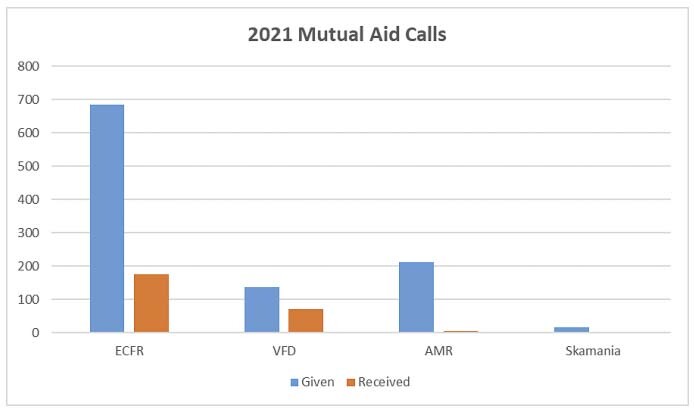
In 2016, the CWFD honored three volunteer firefighters. Jordan Boldt had served for 10 years;. Rick Nieto and Ben Porter had each served for five years. How is it that volunteers are not allowed when they were actually serving the community after the merger?
The 2019 Emergency Services Consulting International final report states there were 15 volunteers on staff. Kevin West reports in the 2021 Annual Report that six new volunteers joined the CWFD. How is it Nohr says they are not allowed?
“CWFD currently has 15 volunteer personnel in the department. They train and serve on 12-hour shifts with career personnel, augmenting their staffing levels. The department has been criticized for having a volunteer program in name only, allowing it to degrade by neglect. ESCI saw no evidence of this while on-site, however, we also saw no champion for the program.”
With city budgets being tight, citizens have asked why not expand volunteer firefighter positions instead of hiring full-time paid positions that Washougal cannot afford?
The Camas City Council appropriated $36.6 million for the CWFD 2023-24 budget. The budget has a line item of $6.8 million in 2023 and $7.4 million in 2024 for “Washougal’s share adjustment.” For the 2021-24 period, Camas will have spent $25.1 million covering the added personnel.
How many firefighters are needed?
Since the creation of the CFWD, all of the increase in calls for service are for ambulance and EMS service. The number of calls for fires has decreased.
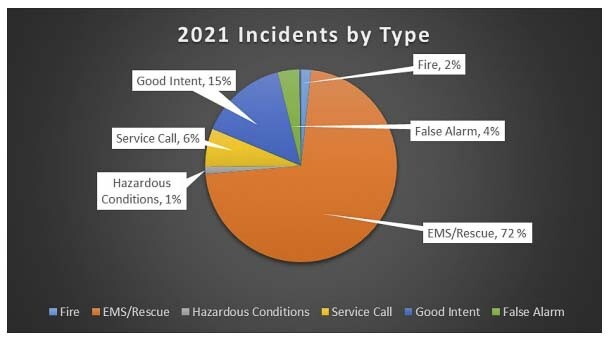
Earlier this month, Prune Hill resident Scott Hogg heard sirens. A minute or two later, three vehicles were at a home on his block. ”A red fire/EMT truck; a big pumper truck, and a police officer all showed up for a medical call,” he said. “There was no fire.” His wife witnessed a similar event two days later near Crown Park. He wondered if this was the best use of city resources.
In 2021, there were only four “significant” fires in Camas and Washougal, an average of one every three months. In 2013, there were seven. In 2016, there were five. Clearly, the trend is good. Significant fires are occurring less often.
On the other hand, calls for EMS service increased significantly in the decade ending 2020. “Over the span of 10 years we have experienced a 51 percent increase in EMS call volume,” they report.
From 2014 to 2018, there was a 16 percent increase in demand for service, with an average increase of 4 percent each year. During this period, fire incidents decreased by 6 percent. Calls labeled EMS made up 72 percent of calls for assistance.
More recently, calls for fire made up only 3 percent of total responses, with another 3.4 percent for alarms. The largest number of calls go to station 43 in Washougal followed by station 41 in downtown Camas. Station 42 in Grass Valley gets less than half the calls of the other two stations. Additionally, East County Fire and Rescue has fire station 91 at Grove Field and another one (95) in east Washougal.
In 2021, total calls were 4,998, up 6 percent from a year earlier. Only two percent of the calls were for fire and four percent were false alarms. Fully 72 percent of calls were for EMS. and 68 percent of EMS calls resulted in ambulance transport to a hospital.
In 2021, the CWFD provided mutual aid four times as often as they received it. There were 1,033 mutual aid calls (20 percent of total) and received mutual aid 250 times.
East County Fire and Rescue receives the largest amount of mutual aid support from the CWFD, followed by AMR ambulance service, and then the Vancouver Fire Department. “The mutual aid to ECFR is higher because we have an EMS levy in place to provide ambulance service in their jurisdiction,” the annual report states.
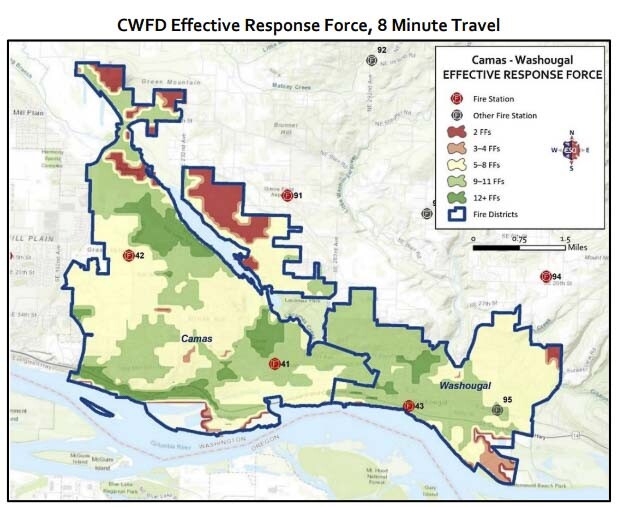
In January 2015, the city of Vancouver selected American Medical Response (AMR) to provide ambulance services within the city, as well as emergency and non-emergency transport services within the Emergency Medical Service District 2 (EMSD2) service area. This was the first time that the city had contracted with a vendor directly to provide these services in more than 20 years.
In 2018, the Vancouver City Council approved a five-year extension of the contract through 2024. A recent annual report indicates AMR handled over 61,000 calls for service on behalf of Vancouver and rural Clark County.
Citizens might wonder why Camas and Washougal can’t do as Portland and Vancouver have done, contracting with AMR or an ambulance service to cover the need for increased ambulance service.
The $40 million bond
In the past year, rumors surfaced that members of the Camas City Council had begun discussing two bonds for the fire department totalling $40 million. One was going to be a $30 million capital bond, placed on the August 2023 ballot, followed by a separate $10 million operating bond on the November 2023 ballot. Neither happened.
At the July 17 council workshop, Camas Fire Chief Cliff Free told the councilors they needed to get to 51 percent. It was a reference to the votes needed to approve a bond to borrow money to build a new fire station. “The biggest lynchpin in the middle is a publicly supported bond to fund that” (new fire station), he said.
The staff recommended hiring a consultant for almost $148,000 in August to evaluate a new site for relocating the downtown Camas station 41. The contract would begin design and get it to a 20 percent completion level, before seeking funding.
Yet it is unknown if the two fire departments will split apart and go their separate ways, or if they will remain together. A third option is the creation of a new Rural Fire Authority (RFA). An unanswered question is “if” the two cities continue the CWFD, then why is Camas picking up the cost of seeking locations for a new headquarters, and mandating 20 percent of the design?
There is active discussion about creating a RFA, potentially with part of the East County Fire and Rescue. If that were to happen, then the fire headquarters could possibly be located at a different location, away from expensive downtown Camas real estate.
Instead, the “solution” recommended by one consultant was the creation of an RFA. This would eliminate the current agreement, and a new government agency would be created with separate taxing authority, to manage and pay for fire service. It was suggested the new agency would include a portion of East County Fire and Rescue.
If an RFA is the desired solution, then why wouldn’t the new entity be in control of fire and EMS coverage and defining what is and isn’t needed for service? Why is Camas spending nearly $148,000 on a consultant when a “solution” hasn’t been agreed upon? There was no mention of Washougal paying 40 percent of the cost.
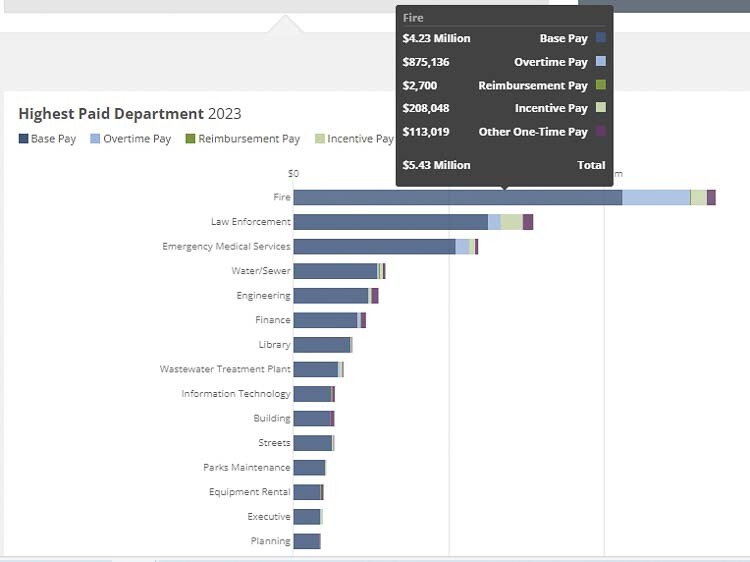
According to the Camas budget, Law Enforcement is 21 percent of the budget and Fire/EMS service is 15 percent of spending. Total wages and salaries have risen from $128 million in 2019 to $222 million for 2024.
In Washougal, Police and Fire/EMS each account for 24 percent of the budget, at $4.5 million each. The Washougal budget is $50 million of which $19 million is the General Fund.
The Camas “Open Budget” shows that for the current year, the fire department is the largest expenditure at $5.4 million. Twenty percent has been paid in overtime. One Battalion Chief received $19,900 in overtime in September.
Also read:
- Rep. John Ley visits empty Brockmann mental health facility, calls for state to fund its operationRep. John Ley criticized the state for failing to fund the $42 million Brockmann mental health facility in Vancouver, which remains empty and fenced despite being ready for operation.
- Washougal MX Park welcomes National and salutes military veterans as wellWashougal MX Park is once again hosting the FLY Racing Washougal National, also serving as the Pro Motocross Championship’s military appreciation event, with over 20,000 fans expected.
- Two GOP state lawmakers consider running against Gluesenkamp PerezTwo Republican state leaders, John Braun and Jim Walsh, are weighing campaigns to unseat U.S. Rep. Marie Gluesenkamp Perez in Washington’s 3rd Congressional District, a nationally watched swing seat.
- Opinion: Vancouver’s new $30 rental fee will increase rents in the cityMark Harmsworth argues Vancouver’s new $30 rental unit fee will raise rents, discourage investment, and worsen affordability, urging the city to repeal the policy and pursue market-driven housing solutions.
- Clark College launches Advanced Manufacturing Program Fall 2025Clark College will debut a new Advanced Manufacturing degree program in Fall 2025 at its Ridgefield facility, offering stackable credentials and hands-on training to support regional workforce needs.
- Opinion: The right speed to exitDoug Dahl of Target Zero explains that while exit-only freeway lanes follow the posted speed limit, drivers are legally required to reduce speed based on safety conditions as they approach offramps.
- Clark County seeks volunteers for four positions on the Clean Water CommissionClark County is seeking four new volunteers to serve on its Clean Water Commission, which advises on surface water quality and watershed health. Applications are due by Aug. 25.











